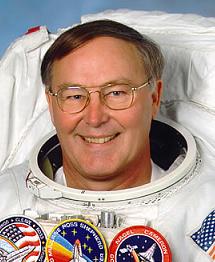Jerry L. Ross
American - (NASA)
Retired
Date of Birth: Jan. 20, 1948
Age: 77
Jerry Lynn Ross is a retired United States Air Force officer and a former NASA astronaut. He is a veteran of seven Space Shuttle missions, making him the joint record holder for most spaceflights (a record he shares with Franklin Chang-Diaz). His papers, photographs and many personal items are in the Barron Hilton Flight and Space Exploration Archives at Purdue University. He was inducted into the Astronaut Hall of Fame during ceremonies in May 2014. Ross is the author of Spacewalker: My Journey in Space and Faith as NASA's Record-Setting Frequent Flyer (Purdue University Press, 2013) with John Norberg. In March 2014 it was announced "Spacewalker" will be available in a French translation through the specialist aerospace publisher Altipresse. Fellow astronaut Chris Hadfield describes Ross in his autobiography, An Astronaut's Guide to Life on Earth, as "the embodiment of the trustworthy, loyal, courteous and brave astronaut archetype."
Space Shuttle Atlantis / OV-104 | STS-61-B
National Aeronautics and Space Administration | United States of AmericaKennedy Space Center, FL, USA
Nov. 27, 1985, 12:29 a.m.
Status: Success
Mission:
STS-61-B was the twenty-third space shuttle mission and the second for the Space Shuttle Atlantis. The shuttle was launched for Kennedy Space Center and the shuttle deployed three communicates satellites. It also tested techniques for constructing structures in orbit. This mission marked the quickest turnaround of a shuttle, just 54 days elapsed beetween this launch and Atlantis' previous mission.
Low Earth OrbitSpace Shuttle Atlantis / OV-104 | STS-27
National Aeronautics and Space Administration | United States of AmericaKennedy Space Center, FL, USA
Dec. 2, 1988, 2:30 p.m.
Status: Success
Mission:
STS-27 was the twenty-seventh and the third for Atlantis. It carried a classified payload for the Department of Defence. The heat shielding was substantially damaged during lift-off, impacting the right wing. The crew narrowly survived re-entry with a steal bar taking the brunt of the heat before beginning to burn through the aluminum structure.
Low Earth OrbitSpace Shuttle Atlantis / OV-104 | STS-37
National Aeronautics and Space Administration | United States of AmericaKennedy Space Center, FL, USA
April 5, 1991, 2:22 p.m.
Space Shuttle Columbia / OV-102 | STS-55
National Aeronautics and Space Administration | United States of AmericaKennedy Space Center, FL, USA
April 26, 1993, 2:50 p.m.
Status: Success
Mission:
STS-55 (Space Transportation System 55), or D-2 was the 55th overall flight of the US Space Shuttle and the 14th flight of Shuttle Columbia. This flight was a multinational Spacelab flight involving 88 experiments from eleven different nations. The experiments ranged from biology sciences to simple earth observations.
Low Earth OrbitSpace Shuttle Atlantis / OV-104 | STS-74
National Aeronautics and Space Administration | United States of AmericaKennedy Space Center, FL, USA
Nov. 12, 1995, 12:30 p.m.
Status: Success
Mission:
STS-74 was the fourth mission of the US/Russian Shuttle-Mir Program, and the second docking of the Space Shuttle with Mir. Space Shuttle Atlantis lifted off from Kennedy Space Center launch pad 39A on 12 November 1995. The mission ended 8 days later with the landing of Atlantis back at Kennedy. It was the second in a series of seven straight missions to the station flown by Atlantis.
Low Earth OrbitSpace Shuttle Endeavour / OV-105 | STS-88
National Aeronautics and Space Administration | United States of AmericaKennedy Space Center, FL, USA
Dec. 4, 1998, 8:35 a.m.
Space Shuttle Atlantis / OV-104 | STS-110
National Aeronautics and Space Administration | United States of AmericaKennedy Space Center, FL, USA
April 8, 2002, 8:44 p.m.
Status: Success
Mission:
STS-110 was a Space Shuttle mission to the International Space Station (ISS) on 8–19 April 2002 flown by Space Shuttle Atlantis. The main purpose was to install the S0 Truss segment, which forms the backbone of the truss structure on the station.
Low Earth OrbitThe National Aeronautics and Space Administration is an independent agency of the executive branch of the United States federal government responsible for the civilian space program, as well as aeronautics and aerospace research. NASA have many launch facilities but most are inactive. The most commonly used pad will be LC-39B at Kennedy Space Center in Florida.
H3-22
Michibiki 5 (QZS-5)
Yoshinobu Launch Complex LP-2 - Tanegashima Space Center, JapanQZSS (Quasi Zenith Satellite System) is a Japanese satellite navigation system operating from inclined, elliptical geosynchronous orbits to achieve o…
Electron
The Wisdom God Guides (iQPS Launch 6)
Rocket Lab Launch Complex 1B - Rocket Lab Launch Complex 1, Mahia Peninsula, New ZealandSynthetic aperture radar Earth observation satellite for Japanese Earth imaging company iQPS.
New Shepard
NS-37
West Texas Suborbital Launch Site/ Corn Ranch - Corn Ranch, Van Horn, TX, USANS-37 is the 16th crewed flight for the New Shepard program and the 37th in the New Shepard program's history.
Long March 5
TJSW-23
101 - Wenchang Space Launch Site, People's Republic of ChinaChinese classified satellite claimed to be for communication technology test purposes. Actual mission not known.
Electron
Don't Be Such A Square (STP-S30)
Rocket Lab Launch Complex 2 (Launch Area 0 C) - Wallops Flight Facility, Virginia, USASTP-S30 is a complex mission that will deliver research experiments and technology demonstrations to orbit for the DoD and contribute to future space…



